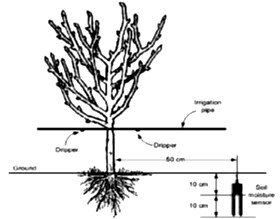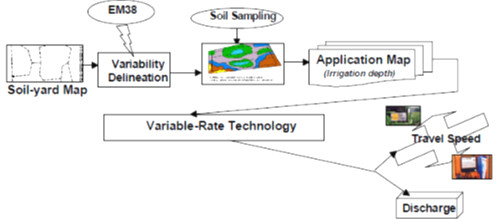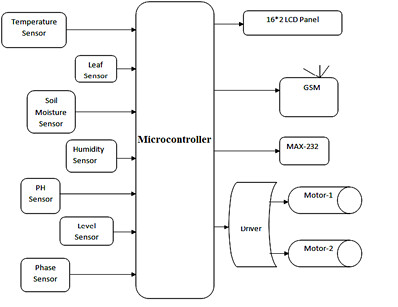Authors: Mukesh Kumar, Ramesh K. Sahni, Abhishek M. Waghaye, Ajit K. Nayak
Scientist, ICAR-Central Institute of Agricultural Engineering, Bhopal-462038
Introduction:
There is no ideal irrigation method available which may be suitable for all types of weather conditions, different soils and crop varieties. These days water management is becoming very popular with the surety of irrigation during the crop growth period. The burgeoning population and urbanization demands the agricultural technologies to be more robust with higher water use efficiency. Marginal farmers and small farmers with low land holdings (2 to 4 ha) heavily depend mainly on the rainfall for their crop production. It has been observed that farmers bear huge loss because of extreme weather condition and incorrect irrigation method. It is imperative to improve the efficiency of irrigation systems and prevent the misuse of water, with an intelligent irrigation system which will enable the farmers to optimize the use of water use efficiency.
Precision irrigation involves the accurate and precise application of water near the vicinity of crop to meet the water requirement of individual plant or group of plants. Precision irrigation is the application of water to the crop at the right time, right amount, right place and right manner which helps to manage the field variability of water and water use efficiency with increasing the crop productivity in a sustainable way to save water resources. The soil-water-plant relationship is very complex and demands specific solution for every problem. Traditional irrigation water management systems utilize a concept of uniform irrigation whereas other uses a system approach to achieve differential irrigation to crop under field variation (spatial and temporal). Precision irrigation system such as drip irrigation, sprinkler irrigation applies water in definite amount with very little loss of water (Fig. 1).

Fig. 1: Drip Irrigation System (Prathyusha et al. 2013)
Benefits of precision irrigation techniques
Water savings
The primary goal of precision irrigation is to apply an optimum amount of irrigation throughout the field. It has been reported that variable rate irrigation could save 10 to 15% of water used in conventional irrigation practice (Yule et al. 2008). Hedley and Yule (2009) suggested that water savings of around 25% are possible through the improvements made in application efficiency which can be obtained by spatially varied irrigation applications.
Yield and profitability
The experimental studies were carried out by King et al. (2006) for measuring the yield of potatoes under spatially varied irrigation application systems. It was reported that yields were better in two consecutive years over and above uniform irrigation system which is the traditional approach.
Components of precision irrigation system
Data acquisition
A Precision Irrigation system should be able to identify and quantify the variability i.e. spatial and temporal variability at the field that exist in soil and crop conditions. The required technology to measure the various components of the soil-crop-atmosphere continuum is available with real-time so as to provide precise and/or real-time control of irrigation applications.
Interpretation
The collected data has to be interpreted and analyzed at an appropriate interval. The inadequate development of decision support systems (DSS) has been identified as a major bottle neck for the interpretation of real time data and adoption of precision agriculture (McBratney et al., 2005).
Control
The important component of a precision irrigation system includes optimization of inputs and adjustment of irrigation management at appropriate temporal and spatial scales. Irrigation system decides the application of differential depths of water over a field. Automatic controllers with real time data collection are available which provide the most reliable and accurate means of controlling the depth of irrigation water to be applied.
Technology associated with precision irrigation
There are many technologies which are associated with precision irrigation are Remote Sensing (RS), Global Positioning System (GPS), Geographical Information System (GIS) and Wireless Sensor Network (WSN).
Wireless sensor networks (WSN) is a network of small sensing devices known as sensor nodes arranged in a distributed manner which communicate with each other on some physical phenomena process and send the information through wireless channel. The sensor nodes are typically a small low-cost devices, low-power, equipped with limited sensing, data processing and wireless communication capabilities with power supply (Wang, 1998).
A wireless sensor is a self-powered device containing a processor for computing purpose. It has a transmitter and receiver with both analog and digital interfaces to sense physical parameters such as temperature, humidity etc. The sensor nodes communicate with each other in order to exchange and process the information collected by their sensing units.
Precision Irrigation strategy
The delineation of the field is carried out to develop spatial variability map of the cropping area. The soil sampling is done to determine the soil properties and available moisture content. The developed map shows the irrigation with different depths of water and their location within the field. The variable-rate technologies are now needed to apply the irrigation according to the requirement shown in the variability map. Figure 2 shows the established strategy for precision irrigation.

Fig. 2: Established strategy for precision irrigation (Karadsheh et al., 2002)
A real time irrigation control system
In real time irrigation control system field condition are monitored using different sensors like Soil moisture sensor, Temperature sensor, Humidity sensor, pH sensor, etc. In an embedded system, a particular set of command are used to operate a particular sensor device interfaced to the microcontroller (Fig. 3).

Fig. 3: Block Diagram of Real-time irrigation control system
A sensor will get activated with an active command sent through the controller. The sensor sends the information it recorded which finally get displayed on the LCD panel. The output readings are sent to the mobile phone of the end user through which the commands are initiated using a text message to operate the system. This facilitates the end user to respond immediately further to provide the proper supply of water for crop irrigation. The other devices like AC motors are operated accordingly to operate the irrigation system. The pH sensor is used to monitor the soil condition, weather the soil having harmful acidic nature or normal base nature. If acidic nature is present means we have to dilute the content and neutralize it or we will provide the necessary fertilizer. The sensors like Temperature and humidity are useful in the case of monitoring the weather conditions (Prathyusha et al. 2013). Therefore, a real time precision irrigation system is the need of the hour in the present context of diminishing water resources. The sustainable use of irrigation water can be achieved with increased water use efficiency.
References:
1. Hedley, C.B. & Yule, I.J. (2009). Soil Water Status Mapping and Two Variable-Rate Irrigation Scenarios. Precision Agriculture, 10, 342-355.
2. Karadsheh, E.A., Sourell, H. and Krause, R. 2002. Precision Irrigation: New strategy irrigation water management. Conference on International Agricultural Research for Development, Deutscher Tropentag. Witzenhausen, pp:1-7.
3. King, B.A., Stark, J.C. and Wall, R.W. (2006). Comparison of Site-Specific and Conventional Uniform Irrigation Management for Potatoes. Applied Engineering in Agriculture, 22(5), pp: 677-688.
4. McBratney, A.B.; Whelan, B.; Ancev, T. & Bouma, J. (2005). Future Directions of Precision Agriculture. Precision Agriculture, 6, pp: 7-23.
5. Prathyusha, K., Bala, G. S., and Ravi, K. S. 2013. A real – time irrigation control system for precision agriculture using WSN in Indian agricultural sectors. International Journal of Computer Science, Engineering and Applications, Vol (3) 4, pp: 75-80.
6. Wang, M. (1998). Development of Precision Agriculture and Engineering Technology Innovation, Transactions of the CSAE, Chinese Society of Agricultural Engineering. Beijing, 15(1), pp 231.
7. Yule, I.J., Hedley, C.B. and Bradbury, S. (2008). Variable-rate irrigation. 12th Annual Symposium on Precision Agriculture Research & Application in Australasia. Sydney.
About Author / Additional Info:
Scientist working at ICAR-Central Institute of Agricultural Engineering, Bhopal